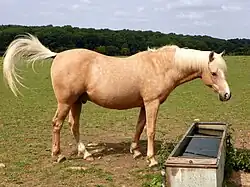巴斯克語
發音
- 國際音標(幫助):/ˈas̺.te/
名詞
變格
(无灵名词)aste的变格
|
派生詞
愛沙尼亞語
詞源1
名詞
(屬格,部分格)
變格
詞源2
名詞
(屬格,部分格)
變格
派生詞
芬蘭語
詞源
源自 + ,1846年由芬蘭醫生、翻譯家Wolmar Schildt所創。
發音
- 國際音標(幫助):/ˈɑsteˣ/, [ˈɑs̠t̪e̞(ʔ)]
名詞
變格
| aste (Kotus 變格類型 48/hame,無層級變化)的變格 | |||
|---|---|---|---|
| 主格 | |||
| 屬格 | |||
| 部分格 | |||
| 入格 | |||
| 單數 | 複數 | ||
| 主格 | |||
| 賓格 | nom. | ||
| gen. | |||
| 屬格 | |||
| 部分格 | |||
| 內格 | |||
| 出格 | |||
| 入格 | |||
| 所格 | |||
| 奪格 | |||
| 向格 | |||
| 樣格 | |||
| 變格 | |||
| 具格 | — | ||
| 缺格 | |||
| 共格 | — | ||
| aste 的所有格形式 (變格類型 hame) | ||
|---|---|---|
| 所有者 | 單數 | 複數 |
| 第一人稱 | ||
| 第二人稱 | ||
| 第三人稱 | ||
派生詞
異序詞
哥特語
羅馬字
意大利語
名詞
f
異序詞
卡累利阿語
詞源
對比芬蘭語 。
名詞
(屬格,部分格)
拉脫維亞語

Zirgs un zirga aste (1)
_Airplane_Tail_-_Feb_2013.jpg.webp)
Lidmašīnas aste (2)
詞源
源自i/n-詞幹的的一 e-詞幹變體,源自原始波羅的語 < 。更遠的原始印歐語來源可能有: (a) ← (“尖的,邊緣的;石頭”)(參見 (“尖的”)),意思由“尖的(東西)” > “螫針” > “尾巴”; (b) < , (“骨”),意思由“骨” > “尾骨” > “尾巴”(參見冰島語 (“狗尾,貓尾”) ← 古諾爾斯語 (“馬尾有骨的部位”))。 (a) 情況中,同源詞包括立陶宛語 (“扦子,魚刺”) (“扦子,魚刺,芒刺”), 教會斯拉夫語 (osŭtŭ, “多刺的水生植物”), (ostŭ, “扦子,魚刺,芒刺”), 俄語 (ostʹ), 捷克語 , 波蘭語 , 俄語 (osot, “多刺的植物”), 保加利亞語 (ósǎt), 捷克語, 波蘭語 。 (b) 情況中,同源詞包括赫梯語 , 梵語 (asthi), 古希臘語 (ostéon), 阿爾巴尼亞語 , 吐火羅語B , 拉丁語 (可能 (“肋骨”)),並可能包括所有 (a) 情況的同源詞,參見原始印歐語 , 。[1]
發音
- 國際音標(幫助):[astɛ]
| 音頻: | (檔案) |
名詞
f (第5變格)
- 〈解〉 尾巴
- zirga aste ― 馬尾
- suņa aste ― 狗尾
- vilka aste ― 狼尾
- gaiļa aste ― 公雞尾羽
- pāva aste ― 孔雀尾羽
- kaķis pa to laiku bija izlavījies no pagalma un, izlējis asti, lēni gāja prom ― the cat, meanwhile, had gotten out of the yard and, straightening (his) tail, slowly went away
- kas sunim asti cels, ja pats necels ― who is going to raise a dog's tail if not for the dog himself
- (物體的) 尾
- lidmašīnas aste ― 飛機尾翼
- kleitas aste ― 裙尾
- komētas aste ― 彗星尾
- garas rindas stāvēja pie kasēm... paša astē iestājās arī tēvs ― there were long lines at the cashiers... father joined at the very tail (= end) (of one of the lines)
使用注意
變格
aste的變格 (第五類變格)
| 單數 (vienskaitlis) | 複數 (daudzskaitlis) | |
|---|---|---|
| 主格 (nominatīvs) | ||
| 賓格 (akuzatīvs) | ||
| 屬格 (ģenitīvs) | ||
| 與格 (datīvs) | ||
| 工具格 (instrumentālis) | ||
| 方位格 (lokatīvs) | ||
| 呼格 (vokatīvs) |
近義詞
派生詞
參考資料
- ↑ Karulis, Konstantīns (1992), “”, Latviešu Etimoloģijas Vārdnīca [拉脫維亞語語源詞典] (拉脫維亞語), Rīga: AVOTS, ISBN 9984-700-12-7
毛里求斯克里奧爾語
詞源
源自法語 。
動詞
參考資料
- Baker, Philip & Hookoomsing, Vinesh Y. 1987. Dictionnaire de créole mauricien. Morisyen – English – Français
北方薩米語
發音
- 國際音標(幫助):/ˈasːte/
動詞
塞舌爾克里奧爾語
詞源
源自法語 。
動詞
參考資料
- Danielle D’Offay et Guy Lionnet, Diksyonner Kreol - Franse / Dictionnaire Créole Seychellois - Français
斯瓦希里语
形容词
- 慢的
变格
This article is issued from Wiktionary. The text is licensed under Creative Commons - Attribution - Sharealike. Additional terms may apply for the media files.